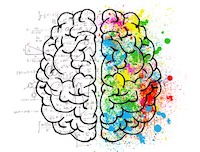Polyvagal Theory is the work of Dr Stephen Porges and describes what we know today about how our nervous system, and entire body, responds to how safe or threatening the world feels to us. This has significant implications for the behaviours we see in ourselves and in others. It’s important to note that we react based on our perception of how safe the world is, and not how safe it actually is.
It should be obvious how Polyvagal Theory is relevant in therapy, but why is it relevant in business? The business world sometimes forgets that they and everyone who works for them is also human and is impacted by everything here. They’re not just cogs in a machine, no matter how much some people would like to think. If we don’t take care of our people then we aren’t taking care of our business.
And there are things in our environments today that push people into, and keep them in, the states that are least productive.
“We now live in a world in which too many people spend far too much time in autonomic states that evolved to temporarily help us survive fleeting danger - and far too little time feeling safe and achieving homeostasis1“2
Polyvagal Theory describes three states that we can be in, that will affect our behaviour. These are social engagement (Green), mobilization (Yellow) and immobilization (Red). Interestingly, it’s possible to be in more than one state at the same time and we’ll look at that a bit later.
Green - Safety or Social Engagement
Green is when we feel safe. Here we activate the ventral vagal complex, a component of the parasympathetic nervous system.
It’s social engagement, health, growth, and restoration. It’s in the green state that we have our best social behaviour, the most compassion, and critical thinking. We’re at our most calm and are at our best for being effective co-regulators. That means that not only are we good, but we’re helping those around us also be good.
Our ability to physically heal will improve when we’re in the green, as well as our ability to digest food and recuperate.
Yellow - Mobilization
Yellow is when we feel danger. We activate the sympathetic nervous system and prepare for fast movement (fight or flight). We may feel panic or restlessness. We may react poorly or exhibit rage or anxiety.
Our physical mobility and defensive systems improve, our blood pressure, heart rate, adrenaline, pain tolerance, and reactivity all increase.
At the same time we lose many of our social behaviours and our ability to accurately understand the emotions of others. Our facial expressions become very flat and we start to speak more in a monotone. Our physical and mental health are impacted, as well as our digestive systems, and our ability to co-regulate with others.
Our ears tune themselves to be more receptive to low frequency sounds (such as predators make), which makes it harder to hear human speech. At the same time, we’re hyperfocused on activity around us. These combine such that people in the yellow cannot pay attention effectively, even if they wanted to.
Red - Immobilization
Red is when we feel threat to life. During Red, we activate the dorsal vagal complex, another part of the parasympathetic nervous system. This is the oldest part of our survival mechanism and intends in part to keep us out of danger by appearing already dead, and also to numb us to any pain should we be actually be dying.
It’s here that we have fainting, bodily shutdown, blacking out, dissociation, numbness, depression, hopelessness, helplessness, and an inability to socially engage and communicate with others.
This is the freeze response.
Our heart rate, blood pressure, depth of breathing, body awareness, awareness of others all decrease. So does our ability to socially engage and communicate.
Combining states
Interestingly, it’s possible to be in more than one state at the same time, even though that might sound contradictory.
In our business context, Green by itself or a Green/Yellow combination are good and productive states. Anything else, indicates that we have a problem.
| Label | State | Behaviour |
|---|---|---|
| Social communication | Green | Social communication |
| Play or dance | Green, Yellow | Social engagement & mobilization |
| Fight or flight | Yellow | Mobilization |
| Intimacy | Green, Red | Social engagement & immobilization |
| Appeasement | Green, Yellow, Red | Social engagement & threat detection |
| Fawning | Yellow, Red | Compliance without co-regulation |
| Shutdown or dissociation | Red | Immobilization |
Office spaces
So let’s talk about how this works in a business environment.
“If we need to be a bit cynical and focus on the bottom line to make our argument, we’ll posit that a worker who feels safe is likely to be more creative, productive, and stick around longer. The modern workplaces’ tendency to be dismissive of this fact is shortsighted and self-defeating. It is a lose-lose for both employers and employees.”2
Polyvagal Theory is clear that the human nervous system craves social interaction. That we must interact with others to be in the Green state, and it’s only in the Green that we get the productivity we want. That might lend credence to the calls to return to a physical office and yet, it also calls into question so many of the things that are in our current offices that happen to be detrimental. Open plan offices, in particular, with their complete lack of privacy, force us into a constant state of Yellow.
“The sound of constant chatter funnels through our brains and demands our attention, forcing us out of a state of focus into the alertness of the Yellow zone. The low-frequency background noise that often emanates from fluorescent lights, ventilation systems, and equipment such as copy machines is interpreted by our neuroception3 as a sign of danger. A complete lack of visual privacy forces us into a constant state of high alert”2
When we factor in the commute, it’s likely to be worse. A commute where we are driving will force us into the Yellow. A commute where we are on a bus or train may allow us to remain in the Green, if it isn’t too busy or chaotic.
Micromanagement will also drive us into the Yellow, as can measurement of individual productivity. It seems that every month we have some new idea for how to measure the productivity of our people and managers understandably are interested in that. The problem is that doing this measurement can actually make productivity worse by forcing people into the Yellow.
“But this feeling of having eyes over our shoulders is an alarming one. On a primal level, it triggers our survival instincts. When we know we aren’t being watched, we are instinctively activated into a state of alertness – and the Yellow system. This isn’t to say that employers shouldn’t monitor employees’ performance or keep an eye on them. But they should know that micromanaging these metrics comes with a real price. The need to be alert and on guard at all times takes a toll on us and prevents us from access the creative and productivity-costing powers of the Green system.”2
True social interaction is definitely going to help though, whether we are physically together or not. We have a tendency, particularly in IT, to put everyone into silos and encourage them to work by themselves.
Polyvagal Theory tells us that this can’t be the way we work all the time. Yes, some people do require solitude and introverts do need time on their own to recharge, but we also have a biological imperative for social interaction. We have to find that right mix that keeps everyone in the Green.
Conclusion
Polyvagal Theory explains so much of the behaviour that we see, and exhibit ourselves, on a regular basis. I encourage you to check out some of Dr Porge’s books on the subject. I particularly enjoyed “The Pocket Guide to the Polyvagal Theory: The Transformative Power of Feeling Safe” and “Our Polyvagal World: How Safety and Trauma Change Us”. It’s the latter that touches on office spaces and the commute.

